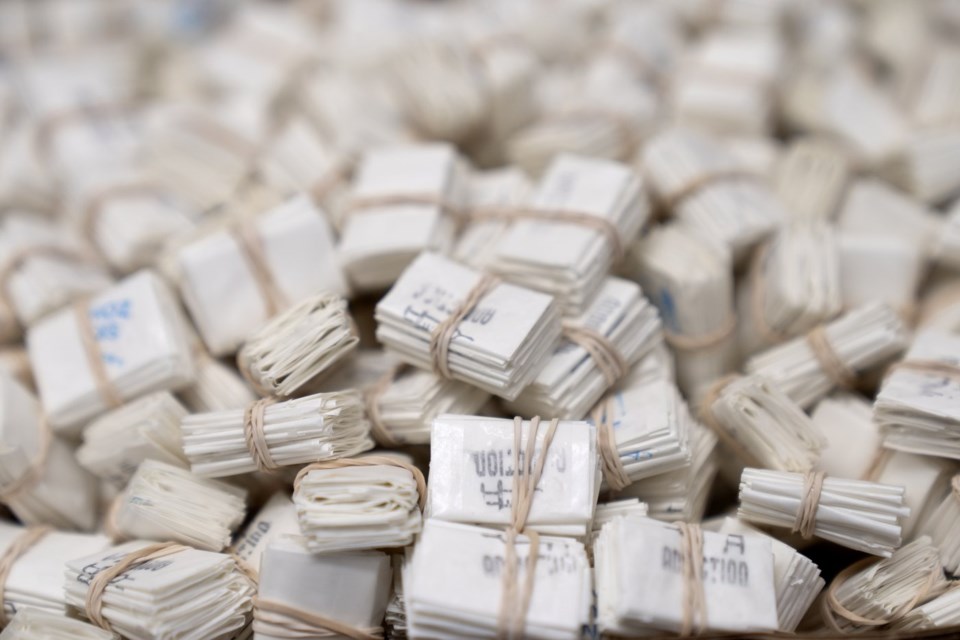WASHINGTON — A new report from a New York-based think tank questions the drug trafficking rationale for U.S. President Donald Trump's tariffs on Canada, saying the data shows the vast majority of fentanyl seizures in the United States are linked to the southern border.
The Manhattan Institute analyzed newly released data on fentanyl and heroin seizures made in the 50 U.S. states and Washington, D.C., from 2013 to 2024, with a focus on the last two years.
The report released earlier this month found that about 99 per cent of the pills and 97 per cent of the powder were found along the border with Mexico. It found that large fentanyl seizures along the Canadian border were relatively rare.
"The main takeaway is that all indications are that the vast majority of fentanyl consumed in the United States arrived via the southwest border with Mexico," co-author Jonathan Caulkins said Thursday.
"Quantities coming from Canada are negligible."
Trump declared an emergency at the northern border in order to use the International Economic Emergency Powers Act of 1977, or IEEPA, to slap Canada with economywide tariffs in March. He partially paused the duties a few days later for imports under the Canada-U.S.-Mexico Agreement on trade.
Canada is also being hit with duties on steel, aluminum and automobiles through a different presidential authority to impose tariffs.
Canadians have pointed to U.S. Customs and Border Protection data that shows a minuscule volume of fentanyl is seized at the northern border. The RCMP have said there is little to no evidence to support that claim that Canadian fentanyl is spreading in the United States.
The Trump administration has dismissed that justification and has maintained that Canada poses a large fentanyl threat.
The Manhattan Institute report said its analysis "contradicts views — such as those used to justify certain tariffs — that treat the flows across the southern and northern borders as being comparably important."
"Imagine someone who tried to pinch pennies by getting a friend to drive him to the airport whenever he took a luxury cruise. Or imagine a dieter who used artificial sweetener in his coffee whenever he ordered cheesecake for dessert," the report said.
"The U.S. effort to try to solve its fentanyl problem by focusing on the northern border with Canada is similar."
The report's publication comes at a tense time in the Canada-U.S. relationship. Canada and the United States are negotiating a new economic and security relationship and have set a July 21 deadline to complete the agreements.
In a call with Canadian media from a summit in Malaysia, Foreign Affairs Minister Anita Anand said Thursday she's optimistic about the timeline for a deal — but hinted it might not occur by the deadline.
She said that a deal is "necessary for the health of our economy" and is being treated as a major priority for the government.
"We are still hopeful that an agreement can be achieved," she said.
Later this month, a federal U.S. appeals court is also set to consider a lower court's ruling that Trump's use of IEEPA to hit countries with tariffs is illegal.
The U.S. Court of International Trade said in May that Trump does not have the authority to impose tariffs on nearly every country using IEEPA — a national security statute that gives the president authority to control economic transactions after declaring an emergency.
Trump's administration pushed back on the ruling and the United States Court of Appeals for the Federal Circuit is scheduled to hear arguments on July 31.
The Manhattan Institute report said that before the United States can act to counter fentanyl trafficking, it must understand how it works. It used data collected by the High Intensity Drug Trafficking Areas' performance management process to look at large seizures around the country.
It found that 32 times as much powder and 78 times as many pills were seized in counties along the Mexican border as in those counties sharing the land border with Canada.
Caulkins, a professor at Heinz College at Carnegie Mellon University, said when it comes to fentanyl, Canada and the U.S. "are in the same boat." Both countries are beset by high overdose death rates from synthetic opioids manufactured outside their borders.
The report said that "whatever the merits or drawbacks of tariffs on imports from Canada — a question of economics and international relations that goes far beyond our analysis — such actions cannot be justified as part of a pragmatic and data-informed response to the threat of fentanyl to the United States."
— With files from Dylan Robertson in Ottawa
This report by The Canadian Press was first published July 10, 2025.
Kelly Geraldine Malone, The Canadian Press



